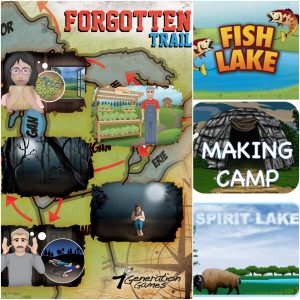We do a lot of research in rural communities, American Indian reservations, small rural schools, social service programs serving people with physical and mental disabilities. We know that funding organizations want to see articles published in peer-reviewed journals (that is a whole ‘nother post), but we know also that only the tiniest portion of the people are games are designed to teach ever read those journals. So, I decided, as the decider in chief at 7 Generation Games (don’t tell Maria!) that I’d publish the latest research in a series of blog posts and also send it out to our mailing lists.
This is a paper Bruce Gillette and I presented at the National Indian Education Association in October of last year. If you didn’t have a chance to attend our session, you can read it here.
Customized Video Games as Effective Education for Tribal Youth
AnnMaria De Mars, Ph.D., 7 Generation Games/ The Julia Group
Bruce Gillette, Circle of Life, Three Affiliated Tribes
Abstract
A four-year research project documented the impact of 3-D video games with math taught in the context of story lines centered on students’ tribal history in raising mathematics test scores. We extend this design to teach decision-making skills for prevention of drug abuse and related issues among high-risk youth. Both results of the initial study and the current design and development will be reviewed.
BACKGROUND
In the United States, Native Americans are both the fastest growing minority group and the lowest performing in mathematics (DeVoe, Darling-Churchill & Snyder, 2008). Over 1,000,000 Native Americans live on federally-designated reservations; students from these sites perform even lower than the mean for all Native Americans (De Mars & Longie, 2011). It has been argued that this negative relationship exists because the time for cultural activities comes out of other academic subjects. Unwilling to accept that students must choose between learning their culture and succeeding in school, The Julia Group and Spirit Lake Consulting, Inc. developed a line of culturally-based games that are designed to raise mathematics achievement and develop computer proficiency.
in the first year, a game to teach number sense and geometry standards was developed and tested on an American Indian reservation. One school served as a control group and the other as the intervention group. (The reservation only had two schools.) After playing the games for 8 weeks, students in the intervention group showed an improvement three times that of the control group. The following year, was spent in revising and expanding assessment measures, designing and testing additional game levels to teach fractions and statistics standards. In the third year, pre-and posttest results again showed significant improvement.
While continuing to expand the depth and breadth of academic content taught, in the fourth year, the project partnered with a reservation substance abuse prevention program to develop a line of games that would address social skills.
INTRODUCTION: Phase I – Mathematics and culture
7 Generation Games has created virtual worlds that are a math simulation game in disguise. The first game is set in the Great Plains region around the time of the first European contact. The computer animation was created based on photographs of the area, and the game characters were based on 19th century photographs. Dr. Erich Longie, Spirit Lake Tribal Historic Preservation Officer and Lorraine Grey Bear, Dakota language instructor, consulted on the authenticity of characters, design and activities. The second game, Fish Lake, tells the story of the Ojibwe migration, with Dr. Carol Davis, Deb Gourneau and Willie Davis, all of Turtle Mountain Band providing consultation on cultural content.
Within the games, students were presented with tasks that use mathematics, aligned with the Common Core standards. At the same time, they learned about their culture and developed computer proficiency. For example, in Spirit Lake: The Game, Tasina must search through the woods to find the herbs her grandmother says will cure the 24 tribal members who are sick; the medicine takes four herbs for each person. When she picks the correct herb, a question pops up asking how many herbs she needs.
As students progress through the game, challenges become increasingly difficult, both in mathematics required and computer proficiency. The game starts with simple problems in the first level as students learn how to play, learn the story line and get hooked on playing the game. The average student should get through the first level in a week. Levels 2 through 5 will address fourth and fifth-grade standards such as “Use negative integers in real-world problems” and “Multiply multi-digit numbers.” When a student answers a challenge incorrectly, he or she will be routed to a page to select a choice for instruction – a video, web page or online activity designed to teach the content. After completing this instruction, the student can return to the game.
The mathematics in Fish Lake, pick up where Spirit Lake: The Game leaves off, with fourth – and fifth grade standards related to fractions. Why fractions? Both published research and the experience of the teachers from reservation schools participating in our pilot projects identified fractions is a key area requiring intervention. For most students, this is the first abstract mathematical concept that they encounter. Understanding fractions is essential before a student can master decimals or most statistical concepts, e.g., the mean is not always waiting to be a whole number.
The third game in the series, Forgotten Trail, was developed in response to suggestions from youth on the reservations who had acted as testers in the first two years. They had requested additional in-game activities such as driving and snowmobiling. The challenge to the development team was how to incorporate contemporary activities and traditional culture.
Read how we solved that challenge and more on how our research progressed in the next post.
If you’d like to get all of our games for under $20, click this link.

